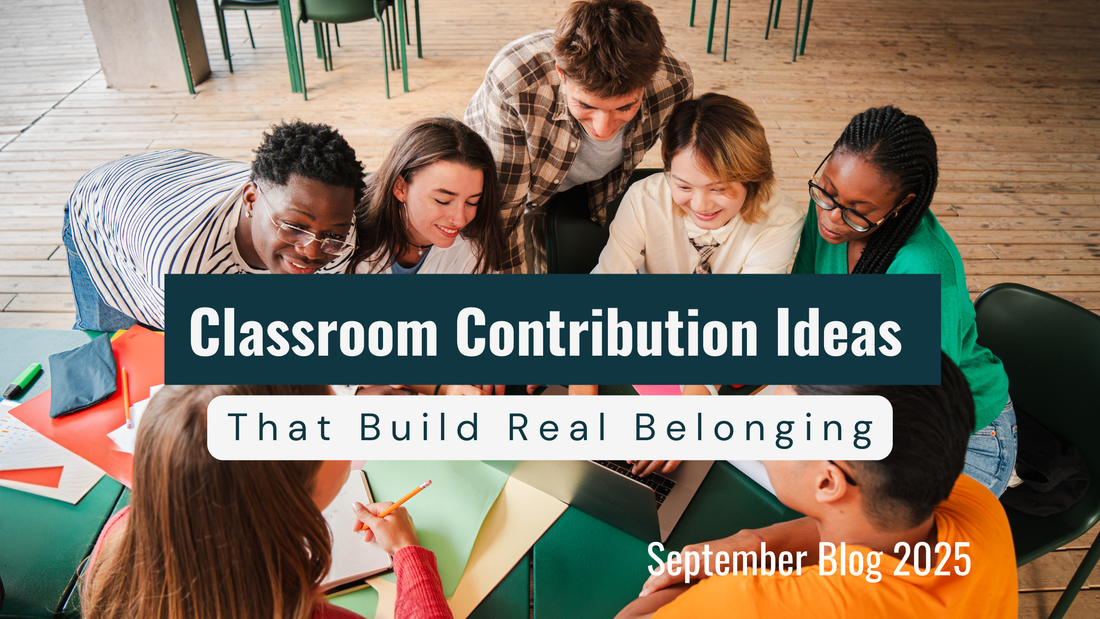
Classroom Contribution Ideas That Build Real Belonging
Share
Classroom Contribution Ideas That Build Real Belonging
How to Design Student Roles That Increase Engagement and Connection
Learn how to create authentic classroom contribution opportunities that help students feel valued, connected, and essential—without adding to your workload.
Why Student Contribution Builds Classroom Belonging
If we want to increase student engagement, attention, and emotional regulation, we have to meet their psychological needs first. At the top of that list? Belonging.
But belonging isn’t about being included in name only. Students feel real belonging when they’re trusted, relied on, and needed.
And one of the most powerful ways to meet that need is through authentic classroom contribution.
When students take on meaningful classroom roles—especially roles that help the class function—they feel essential, not optional. That tells their brain: you belong here.
How to Spot Contribution Opportunities in Your Routine
You don’t need a brand-new curriculum or a big project. Contribution opportunities are hiding in the routines you already use. Look at the beginning and end of class, transitions, small group work, and daily warm-ups.
Ask yourself:
-
Is there information a student can share instead of me?
-
Is there a decision a student can make for the group?
-
Is there a tool, material, or timer a student can manage?
-
Is there any routine I’m currently doing for students that they could do for each other?
These may feel small, but the brain interprets contribution as connection. That’s how belonging begins.
Example: A Student-Led Reflection Routine
Let’s break down what a full student contribution system could look like—no fluff, just a real example.
Routine: Daily reflection + peer sharing
Here’s how students can run the process:
Start of class:
-
Announcer reads the reflection question aloud and flips the sentence stem poster.
-
Timekeeper starts a 3-minute timer.
-
Announcer gives a 2-minute warning. Timekeeper resets the timer.
Transition to partner sharing:
-
Moderator picks a partner activity using popsicle sticks, a spinner, or a digital wheel.
-
Class DJ plays 30 seconds of a pre-approved class playlist song to signal transition.
-
Distributor passes out partner share sheets.
Partner share begins:
-
Moderator announces the 3-minute timer. Timekeeper sets it.
-
After 3 minutes, Moderator announces “2-minute warning.” Timekeeper sets a new timer.
Move to individual reflection:
-
Moderator calls everyone back and announces “2 minutes for refinement.” Timekeeper starts the timer.
-
Announcer flips the sentence stem poster and reminds students to use the prompts.
Whole group closure:
-
Moderator gives a final 1-minute call.
-
Timekeeper runs the final timer.
-
Collector gathers partner share sheets.
-
Moderator leads the class in reciting their 3 shared values or class norms.
-
Announcer reads the group discussion question.
Every role matters. And more importantly, every student sees that they matter.
Why Authentic Student Roles Improve Behavior and Focus
This isn’t about “giving students jobs.” It’s about creating student agency, shared responsibility, and collective rhythm.
The nervous system tracks those signals of safety. When students are trusted to lead, contribute, and guide their peers, their stress response softens. Their brains shift from protection mode into learning mode.
You don’t need a behavior chart. You need a contribution system.
Up Next: How to Teach These Roles Without Chaos
In the next episode, we’ll dig into how to explicitly teach contribution routines so students step into these roles with success, not confusion (and you don’t end up managing 10 jobs by yourself).
We'll cover:
-
How to introduce roles
-
Practice scripts for modeling each job
-
How to gradually release responsibility
-
What to do when it falls apart (because it will, at first)
📥 Want to make sure you don’t miss it? Subscribe to the blog series or grab the full Neurodivergent Toolkit.
Get the Full Framework: The Neurodivergent Toolkit
If you’re ready to meet all five core student needs—not just belonging—get the Neurodivergent Toolkit. You’ll also unlock the limited-time Behavior as Communication Workshop that explains why certain behaviors happen and how to support them from the inside out.







